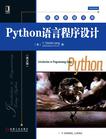Python语言程序设计
出版时间:2013-3 出版社:机械工业出版社 作者:(美)Y. Daniel Liang
Tag标签:无
内容概要
本书保持了Liang博士系列丛书中一贯的、标志性的教与学的哲学:以实例教,由实践学。书中采用了他所提出的已经经过实践检验的“基础先行”的方法,即在定义类之前,首先使用清晰简明的语言介绍基本程序设计概念,如选择语句、循环和函数;在介绍面向对象程序设计和GUI编程之前,首先介绍基本逻辑和程序设计概念。书中除了给出一些以游戏和数学为主的典型实例外,还在每章的开始使用简单的图形给出一两个例子,以激发学生的学习兴趣。
本书特色
以“基础先行”方法介绍基本程序设计概念和方法,帮助学生循序渐进地学习所有必需和重要的基本概念。
以“问题驱动”方法讲授程序设计技术,强调问题求解,而非语法。通过广泛的趣味性实例(涉及数学、自然科学、商业、金融、游戏、动画和多媒体领域)来激发学生的学习兴趣,为求解这些问题,适时地引入相关的语法和库。
可以灵活介绍GUI相关主题。第1~6章使用内置的Turtle图形模块,其余部分使用Tkinter,这两种工具都是简单、易学的程序设计教学工具。每章的开始都有GUI实例,每章末尾还有专门的GUI练习。
作者简介
作者:(美)梁勇梁勇(Y.Daniel Liang),普度大学终身教授,阿姆斯特朗亚特兰大州立大学计算机科学系教授他所编写的Java教程在美国大学Java课程中采用率极高,同时他还兼任Prentice Hall Java系列丛书的编辑。
书籍目录
Chapter 1 Introduction to Computers, Programs, and Python 1.1 Introduction 1.2 What Is a Computer? 1.3 Programming Languages 1.4 Operating Systems 1.5 The History of Python 1.6 Getting Started with Python 1.7 Programming Style and Documentation 1.8 Programming Errors 1.9 Getting Started with Graphics ProgrammingChapter 2 Elementary Programming 2.1 Introduction 2.2 Writing a Simple Program 2.3 Reading Input from the Console 2.4 Identifiers 2.5 Variables, Assignment Statements, and Expressions 2.6 Simultaneous Assignments 2.7 Named Constants 2.8 Numeric Data Types and Operators 2.9 Evaluating Expressions and Operator Precedence 2.10 Augmented Assignment Operators 2.1 I Type Conversions and Rounding 2.12 Case Study: Displaying the Current Time 2.13 Software Development Process 2.14 Case Study: Computing DistancesChapter 3 Mathematical Functions, Strings, and Objects 3.1 Introduction 3.2 Common Python Functions 3.3 Strings and Characters 3.4 Case Study: Minimum Number of Coins 3.5 Introduction to Objects and Methods 3.6 Formatting Numbers and Strings 3.7 Drawing Various Shapes 3.8 Drawing with Colors and FontsChapter 4 Selections 4.1 Introduction 4.2 Boolean Types, Values, and Expressions 4.3 Generating Random Numbers 4.4 if Statements 4.5 Case Study: Guessing Birthdays 4.6 Two-Way if-else Statements 4.7 Nested if and Multi-Way if-elif-else Statements 4.8 Common Errors in Selection Statements 4.9 Case Study: Computing Body Mass Index 4.10 Case Study: Computing Taxes 4.11 Logical Operators 4.12 Case Study: Determining Leap Years 4.13 Case Study: Lottery 4.14 Conditional Expressions 4.15 Operator Precedence and Associativity 4.16 Detecting the Location of an ObjectChapter 5 Loops 5. I Introduction 5.2 The while Loop 5.3 The for Loop 5.4 Nested Loops 5.5 Minimizing Numerical Errors 5.6 Case Studies 5.7 Keywords break and continue 5.8 Case Study: Displaying Prime Numbers 5.9 Case Study: Random WalkChapter 6 Functions 6.1 Introduction 6.2 Defining a Function 6.3 Calling a Function 6.4 Functions with/without Return Values 6.5 Positional and Keyword Arguments 6.6 Passing Arguments by Reference Values 6.7 Modularizing Code 6.8 Case Study: Converting Decimals to Hexadecimals 6.9 The Scope of Variables 6.10 Default Arguments 6.11 Returning Multiple Values 6.12 Case Study: Generating Random ASCII Characters 6.13 Function Abstraction and Stepwise Refinement 6.14 Case Study: Reusable Graphics FunctionsChapter 7 Objects and Classes 7.1 Introduction 7.2 Defining Classes for Objects 7.3 UML Class Diagrams 7.4 Immutable Objects vs. Mutable Objects 7.5 Hiding Data Fields 7.6 Class Abstraction and Encapsulation 7.7 Object-Oriented ThinkingChapter 8 More on Strings and Special Methods 8.1 Introduction 8.2 The strClass 8.3 Case Study: Checking Palindromes 8.4 Case Study: Converting Hexadecimals to Decimals 8.5 Operator Overloading and Special Methods 8.6 Case Study: The Rational ClassChapter 9 GUI Programming Using Tkinter 9.1 Introduction 9.2 Getting Started with Tkinter 9.3 Processing Events 9.4 The Widget Classes 9.5 Canvas 9.6 The Geometry Managers 9.7 Case Study: Loan Calculator 9.8 Displaying Images 9.9 Menus 9.10 Popup Menus 9.11 Mouse, Key Events, and Bindings 9.12 Animations 9.13 Scrollbars 9.14 Standard Dialog BoxesChapter 10 Lists 10.1 Introduction 10.2 List Basics 10.3 Case Study: Lotto Numbers 10.4 Case Study: Deck of Cards 10.5 Deck of Cards GUI 10.6 Copying Lists 10.7 Passing Lists to Functions 10.8 Returning a List from a Function 10.9 Case Study: Counting the Occurrences of Each Letter 10.10 Searching Lists 10.11 Sorting Lists 10.12 Case Study: Bouncing BallsChapter 11 Multidimensional Lists 11.1 Introduction 11.2 Processing Two-Dimensional Lists 11.3 Passing Two-Dimensional Lists to Functions 11.4 Problem: Grading a Multiple-Choice Test 11.5 Problem: Finding the Closest Pair. 11.6 GUI: Finding the Closest Pair 11.7 Problem: Sudoku 11.8 Case Study: Sudoku GUI 11.9 Multidimensional ListsChapter 12 Inheritance and Polymorphism 12. I Introduction 12.2 Superclasses and Subclasses 12.3 Overriding Methods 12.4 The object Class 12..5 Polymorphism and Dynamic Binding 12.6 The isinstance Function 12.7 Case Study: A Reusable Clock 12.B Class Relationships 12.9 Case Study: Designing the Course Class 12,10 Designing a Class for Stacks 12.11 Case Study: The FigureCanvas ClassChapter I3 Files and Exception Handling 13.1 Introduction 13.2 Text Input and Output 13.3 File Dialogs 13.4 Case Study: Counting Each Letter in a File 13.5 Retrieving Data from the Web 13.6 Exception Handling 13.7 Raising Exceptions 13.8 Processing Exceptions Using Exception Objects 13.9 Defining Custom Exception Classes 13.10 Binary IO Using Pickling 13.1 I Case Study: Address BookChapter 14 Tuples, Sets, and Dictionaries 14.1 Introduction 14.2 Tuples 14.3 Sets 14.4 Comparing the Performance of Sets and Lists 14,5 Case Study: Counting Keywords 14.6 Dictionaries 14.7 Case Study: Occurrences of WordsChapter 15 Recursion 15.1 Introduction 15.2 Case Study: Computing Factorials 15.3 Case Study: Computing Fibonacci Numbers 15.4 Problem Solving Using Recursion 15.5 Recursive Helper Functions 15.6 Case Study: Finding the Directory Size 15.7 Case Study: Towers of Hanoi 15.8 Case Study: Fractals 15.9 Case Study: Eight Queens 15.10 Recursion vs. Iteration 15.11 Tail RecursionA detailed table of contents for the Web chapters is available on thecompanion Website:Chapter 1 6 Developing Efficient AlgorithmsChapter 17 SortingChapter 18 Linked Lists, Stacks, Queues, and Priority QueuesChapter 19 Binary Search TreesChapter 20 AVL TreesChapter 21 Hashing: Implementing Dictionaries and SetsChapter 22 Graphs and ApplicationsChapter 23 Weighted Graphs and ApplicationsAPPENDIXES Appendix A Python Keywords Appendix B The ASCII Character Set Appendix C Number SystemsINDEXCREDITS
编辑推荐
梁勇编著的《Python语言程序设计(英文版)》保持了Liang博士系列丛书中一贯的、标志性的教与学的哲学:以实例教,由实践学。书中采用了他所提出的已经经过实践检验的“基础先行”的方法,即在定义类之前,首先使用清晰简明的语言介绍基本程序设计概念,如选择语句、循环和函数;在介绍面向对象程序设计和GUI编程之前,首先介绍基本逻辑和程序设计概念。书中除了给出一些以游戏和数学为主的典型实例外,还在每章的开始使用简单的图形给出一两个例子,以激发学生的学习兴趣。
图书封面
图书标签Tags
无
评论、评分、阅读与下载
用户评论 (总计4条)
- 书写的挺好的,自己英文完全可以对付,programming
- 很不错,非常满意,很实惠
- 内容很赞,就是纸张太烂了,有盗版的嫌疑
- 第一个好处是确实是基于3.0,py3和py2的区别还是很大的,这一点起码让你专注于3,对初学者,并且选择3入手的比较有用。第二个好处就是用图形设计做例子,图形给人的效果肯定是胜过字符的,这让你更有动力完成后面的习题。趣味性更足。第三个好处就是按作者自己的理论体系组织了章节,针对各章在教授入门的前提下都分别有所偏重,逐步引导初学者登堂入室。这个要赞一下。第四个好处就是如果阅读英文难度不大的话,起码避免了不良翻译给人带来的困惑,国内译文的质量实在让人不能恭维。建议具有一定英文的初学者选择此书,确实不错的。
相关图书
- 滚吧,生活
- Access数据库应用技术实验指导与习题
- Access数据库基础及应用
- 2-3岁-幼儿数学潜能大开发
- CorelDRAW艺术设计
- C语言与程序设计
- C语言程序设计学习与实验指导
- C程序设计
- C语言程序设计
- C语言程序设计学习指导
- PLC应用技术
- Web技术基础
- C/C++程序设计
- Linux 网络服务与管理
- Web应用系统设计
- EDA技术及应用
- Oracle数据库实用教程
- Visual Basic程序设计实验指导
- 21世纪普通高校计算机公共课程规划教材
- 变频技术及应用
- 成本会计理论与实务
- 道家窖藏武功摄生秘笈
- 登山健身指南
- 城乡公共服务设施配置理论与实证研究
- 多源信息融合理论及应用
